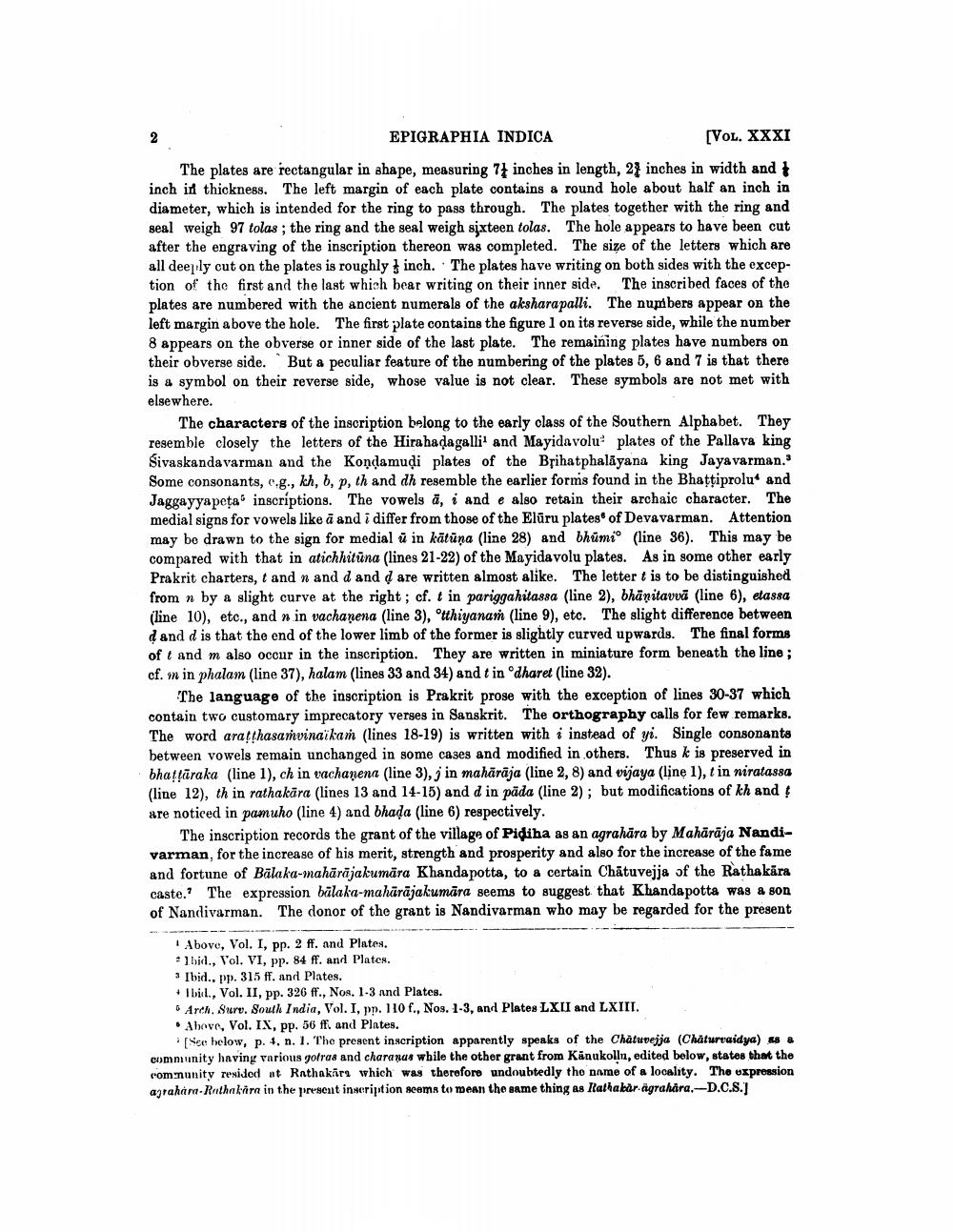________________
2
EPIGRAPHIA INDICA
[VOL. XXXI
The plates are rectangular in shape, measuring 7 inches in length, 2 inches in width and inch in thickness. The left margin of each plate contains a round hole about half an inch in diameter, which is intended for the ring to pass through. The plates together with the ring and seal weigh 97 tolas; the ring and the seal weigh sixteen tolas. The hole appears to have been cut after the engraving of the inscription thereon was completed. The size of the letters which are all deeply cut on the plates is roughly inch. The plates have writing on both sides with the exception of the first and the last which bear writing on their inner side. The inscribed faces of the plates are numbered with the ancient numerals of the aksharapalli. The numbers appear on the left margin above the hole. The first plate contains the figure 1 on its reverse side, while the number 8 appears on the obverse or inner side of the last plate. The remaining plates have numbers on their obverse side. But a peculiar feature of the numbering of the plates 5, 6 and 7 is that there is a symbol on their reverse side, whose value is not clear. These symbols are not met with elsewhere.
The characters of the inscription belong to the early class of the Southern Alphabet. They resemble closely the letters of the Hirahadagalli1 and Mayidavolu plates of the Pallava king Sivaskandavarman and the Kondamuḍi plates of the Brihatphalayana king Jayavarman.3 Some consonants, c.g., kh, b, p, th and dh resemble the earlier forms found in the Bhattiprolu and Jaggayyapeta inscriptions. The vowels a, i and e also retain their archaic character. The medial signs for vowels like a and i differ from those of the Eluru plates of Devavarman. Attention may be drawn to the sign for medial u in katuna (line 28) and bhumi (line 36). This may be compared with that in atichhituna (lines 21-22) of the Mayidavolu plates. As in some other early Prakrit charters, t and n and d and d are written almost alike. The letter t is to be distinguished from n by a slight curve at the right; cf. t in pariggahitassa (line 2), bhänitavvä (line 6), etassa (line 10), etc., and n in vachanena (line 3), °tthiyanam (line 9), etc. The slight difference between d and d is that the end of the lower limb of the former is slightly curved upwards. The final forms of t and m also occur in the inscription. They are written in miniature form beneath the line; cf. m in phalam (line 37), halam (lines 33 and 34) and t in °dharet (line 32).
The language of the inscription is Prakrit prose with the exception of lines 30-37 which contain two customary imprecatory verses in Sanskrit. The orthography calls for few remarks. The word araṭṭhasamvinaikam (lines 18-19) is written with i instead of yi. Single consonants between vowels remain unchanged in some cases and modified in others. Thus k is preserved in bhattaraka (line 1), ch in vachanena (line 3), j in mahārāja (line 2, 8) and vijaya (line 1), t in niratassa (line 12), th in rathakara (lines 13 and 14-15) and d in pada (line 2); but modifications of kh and t are noticed in pamuho (line 4) and bhada (line 6) respectively.
The inscription records the grant of the village of Pidiha as an agrahara by Mahārāja Nandivarman, for the increase of his merit, strength and prosperity and also for the increase of the fame and fortune of Balaka-mahārājakumāra Khandapotta, to a certain Chatuvejja of the Rathakara caste. The expression balaka-mahārājakumāra seems to suggest that Khandapotta was a son of Nandivarman. The donor of the grant is Nandivarman who may be regarded for the present
Above, Vol. I, pp. 2 ff. and Plates.
1bid., Vol. VI, pp. 84 ff. and Plates.
3 Ibid., pp. 315 ff. and Plates.
+Ibid., Vol. II, pp. 326 ff., Nos. 1-3 and Plates.
Arch. Surv. South India, Vol. I, pp. 110 f., Nos. 1-3, and Plates LXII and LXIII.
Above, Vol. IX, pp. 56 ff. and Plates.
[See below, p. 4. n. 1. The present inscription apparently speaks of the Chatuvejja (Chaturvaidya) as a community having various gotras and charanas while the other grant from Kanukolln, edited below, states that the community resided at Rathakars which was therefore undoubtedly the name of a locality. The expression agrahara-Rathakara in the present inscription seems to mean the same thing as Rathakar ägrahara.-D.C.S.]




